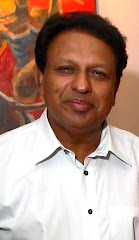Remarks by T.P.Sreenivasan at a function to release Gautaman Bhaskaran's Book on Adoor Gopalakrishnan November 30, 2010
‘Adoor Gopalakrishnan- A Life in Cinema’ is an extraordinary book on an exceptional film maker. I have been an ardent admirer of Adoor for a long time. I am now an admirer also of Gautaman Bhaskaran for elevating the genre of biography to an artistically higher level, close to a novel for readability and felicity of language. Adoor and his movies come out of this book as a composite whole, inseparable and indistinguishable from each other. The man and the movies are one. Adoor hopes that the book will throw some light on his life and work. Gautaman Bhaskaran does more than that- he shows Adoor and his work in a new light.
For practicing diplomats like me, India’s icons, whether they are writers, artists, poets or film personalities constitute the soft power of India, which has been an instrument of our foreign policy. Different film personalities captivated the imagination of people in different countries-Raj Kapoor and Nargis in the Soviet Union, Amitabh Bachan and Sharukh Khan in West and East Asia and Satyajit Ray in earlier years and Adoor more recently in the US and Europe. Adoor retrospectives were common in the US as well as in Austria, where I was invited to share the honour with the film maker and India. I was glad to see that connoisseurs in these and other countries related to the art films of India more than to the mélange of dance and music of Bollywood.
It is difficult to capture in a few minutes the doors that Gautaman Bhaskaran has opened to Adoor and his cinema in his book. All of us knew well that Adoor made films about real people and real situations and that there was nothing artificial or superficial in them. But the author takes us through Adoor’s background, upbringing, interest in Kathakali and theatre, the profound influence of Gandhi on him and the expertise he acquired in Krishnanattam and Koodiyattam and shows us how each of these facets comes through in his work. Whether the author is narrating the events of Adoor’s early life, as a biographer should or whether he is reviewing each of his films as a critic should, his focus is on the unique features of the Adoor cinema. The two sections of the book, the first on Adoor’s life and the second on his movies, merge into each other to reveal the genius of Adoor and its manifestation on the screen. His accomplishment is in persuading Adoor, a reluctant conversationalist, to talk and weave his insights into a remarkable biography.
Gautaman Bhaskaran deals with some of the misconceptions about Adoor’s work. For instance, many people place Adoor in the Satyajit Rray School of movie-making. The criticism that Ray exploited Indian poverty has been hurled at Adoor also. Adoor may have been attracted to Ray’s cinema, but the very fact that Ray considered Adoor his most favourite Indian director shows that his work is far different from Ray’s own. “Had my work resembled Ray’s, he would have had nothing but disdain for me”, the author quotes Adoor as saying, although Adoor considered Ray a constant source of creative energy and inspiration.
Gautaman Bhaskaran also examines the unease that spectators feel when there is silence on the screen, a feature of Adoor’s work. Adoor’s sparing use of background music has also been criticized. In Kodiyettam, Adoor did not use background score at all. The author explores the world of other sounds that Adoor uses and the great lengths to which he goes to record the commonest of sounds to be used with great effect to accomplish the right balance of sound and silence. People with the ear for these sounds will not miss the musical score in Adoor’s movies. Adoor believes that silence exists with sound, between sounds. Sometimes, silence accentuates sound.
An amusing section of the book is on the non-human actors, the birds, the animals and the fish which make Adoor’s films richer with their presence and histrionics. The rat becomes an actor in Elipathayam, crows and mynahs come to life in Mathilukal. The story of how a Swiss- bred cow, masquerading as a nadan pasu, made Adoor rewrite the scene in Kathapurushan is amusing indeed.
The last few days since Kurien Sabarigiri invited me to this event have been Adoor Gopalakrishnan days for me. After I began reading the book, I heard Adoor speaking on Koodiyattam, saw him at the Hay Festival and watched three of his latest movies, starting with Nizhalkkuthu, my all time favourite among Adoor’s movies. As I conclude this brief comment on the book on Adoor Gopalakrishnan, the thought that occurs to me is one of gratitude that we, in Thiruvananthapuram, are blessed that we are Adoor’s contemporaries and we have the privilege of seeing this great film maker not only on celluloid, but also in flesh and blood. I am glad that Gautaman Bhaskaran has given us a glimpse of the genius of this great son of Kerala. When we see Kodiyettam, Elippathayam, Nizhalkkuthu or a new creation by Adoor, we will enjoy these creations even more, thanks to this brilliant biography.
Tuesday, November 30, 2010
Subscribe to:
Post Comments (Atom)

1 comment:
sir,
i was there for todays function,and i simply feel that your sense of humor made you stand out from the crowd.
Post a Comment